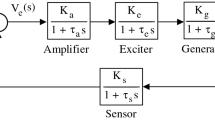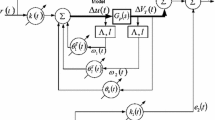Abstract
Automatic voltage regulator (AVR) system is an important equipment in power system for maintaining the terminal voltage of the generator at a specific level. Recently, fractional order PID controller has been designed for AVR system. However, many fractional order PID controller designing methods need to calculate various performance indices in time domain and frequency domain in the process of parameter tuning, which is a tedious and complex process and satisfactory performance can not be obtained. In this paper, a new fractional order PID controller designing method is proposed AVR system based on Bodes reference model. The optimal parameters of FOPID controller is obtained through minimizing the integrated absolute error (IAE) between the output of the Bodes ideal reference model and that of the plant. Particle swarm optimization (PSO) is responsible to search the solution of the IAE criterion, i.e., the parameters of FOPID controller. Extensive simulations and comparisons show that the designed FOPID controller has more excellent performance. Meanwhile, PSO algorithm is effective for searching the optimal FOPID controller parameters.












Similar content being viewed by others
References
Ahmad W, Htut MM (2009) Neural-tuned PID controller for point-to-point (PTP) positioning system: model reference approach. In: Proceedings of the 5th international colloquium signal processing and its applications CSPA 2009, pp 140–144
Barbosa RS, Machado JAT, Ferreira IM (2004) Tuning of PID controllers based on Bode’s ideal transfer function. Nonlinear Dyn 38:305–321
Biswas A, Das S, Abraham A, Dasgupta S (2009) Design of fractional-order PI\(^\lambda\)D\(^\mu\) controllers with an improved differential evolution. Eng Appl Artif Intell 22(2):343–350
Bode HW (1945) Network analysis and feedback amplifier design. Van Nostrand, New York
Cervera J, Banos A, Monje C, Vinagre B (2006) Tuning of fractional PID controllers by using QFT. In: Proceedings of the IEEE industrial electronics, IECON 2006—32nd annual conference on, pp 5402–5407
Charef A, Sun HH, Tsao YY, Onaral B (1992) Fractal system as represented by singularity function. IEEE Trans Autom Control 37(9):1465–1470
Chatterjee A, Mukherjee V, Ghoshal S (2009) Velocity relaxed and craziness-based swarm optimized intelligent PID and PSS controlled AVR system. Int J Electr Power Energy Syst 31(7–8):323–333
Clerc M, Kennedy J (2002) The particle swarm—explosion, stability, and convergence in a multidimensional complex space. IEEE Trans Evolut Comput 6(1):58–73
Demello FP, Concordia C (1969) Concepts of synchronous machine stability as affected by excitation control. IEEE Trans Power Appar Syst PAS-88(4):316–329
Devaraj D, Selvabala B (2009) Real-coded genetic algorithm and fuzzy logic approach for real-time tuning of proportional-integral—derivative controller in automatic voltage regulator system. IET Gener Transm Distrib 3(7):641–649
Eberhart R, Yuhui S (2001) Particle swarm optimization: developments, applications and resources. In: Proceedings of IEEE international conference on evolutionary computation. IEEE, Seoul, pp 81–86
El-Zonkoly A (2006) Optimal tuning of power systems stabilizers and AVR gains using particle swarm optimization. Expert Syst Appl 31(3):551–557
Engheta N (1996) On fractional calculus and fractional multipoles in electromagnetism. IEEE Trans Antennas Propag 44(4):554–566
Flynn D, Hogg BW, Swidenbank E, Zachariah KJ (1996) A self-tuning automatic voltage regulator designed for an industrial environment. IEEE Trans Energy Convers 11(2):429–434
Gaing ZL (2004) A particle swarm optimization approach for optimum design of PID controller in AVR system. IEEE Trans Energy Convers 19(2):384–391
Gozde H, Taplamacioglu M (2011) Comparative performance analysis of artificial bee colony algorithm for automatic voltage regulator (AVR) system. J Frankl Inst 348(8):1927–1946
He YL, Wang XZ, Huang JZ (2016) Fuzzy nonlinear regression analysis using a random weight network. Inf Sci. doi:10.1016/j.ins.2016.01.037 (in press)
Ibrahim AS, Hogg BW, Sharaf MM (1989) Self-tuning automatic voltage regulators for a synchronous generator. IEE Proc D Control Theory Appl 136(5):252–260
Jiang M, Luo YP, Yang SY (2007) Stochastic convergence analysis and parameter selection of the standard particle swarm optimization algorithm. Inf Process Lett 102(1):8–16
Kadirkamanathan V, Selvarajah K, Fleming PJ (2006) Stability analysis of the particle dynamics in particle swarm optimizer. IEEE Trans Evolut Comput 10(3):245–255
Kennedy J, Eberthart R (1995) Particle swarm optimization. In: Proceedings of IEEE international conference on neural networks. IEEE, pp 1942–1948
Kim DH, Hong WP, Park JI (2002) Auto-tuning of reference model based PID controller using immune algorithm. In: Proceedings of the congress on evolutionary computation CEC ’02, vol 1, pp 483–488
Kundur P (1994) Power system stability and control. McGraw-Hill, New York
Lee CH, Chang FK (2010) Fractional-order PID controller optimization via improved electromagnetism-like algorithm. Expert Syst Appl 37(12):8871–8878
Lian ZG, Gu XS, Jiao B (2006) A similar particle swarm optimization algorithm for permutation flowshop scheduling to minimize makespan. Appl Math Comput 175(1):773–785
Lin CM, Li MC, Ting AB (2011) A robust self-learning PID control system design for nonlinear systems using a particle swarm optimization algorithm. Int J Mach Learn Cybern 2(4):225–234
Mazandarani M, Najariyan M (2014) Differentiability of type-2 fuzzy number-valued functions. Commun Nonlinear Sci Numer Simul 19(3):710–725
Mazandarani M, Najariyan M (2014) Type-2 fuzzy fractional derivatives. Commun Nonlinear Sci Numer Simul 19(7):2354–2372
Monje CA, Vinagre BM, Feliu V, Chen Y (2008) Tuning and auto-tuning of fractional order controllers for industry applications. Control Eng Pract 16(7):798–812
de Moura Oliveira P, Pires ES, Novais P (2015) Design of posicast PID control systems using a gravitational search algorithm. Neurocomputing 167:18–23
Mukherjee V, Ghoshal S (2007) Intelligent particle swarm optimized fuzzy PID controller for AVR system. Electr Power Syst Res 77(12):1689–1698
Najariya M, Farahi MH (2013) Optimal control of fuzzy linear controlled system with fuzzy initial conditions. Iran J Fuzzy Syst 10:21–35
Najariyan M, Farahi MH (2015) A new approach for solving a class of fuzzy optimal control systems under generalized Hukuhara differentiability. J Frankl Inst 352(5):1836–1849
Ou B, Song L, Chang C (2010) Tuning of fractional PID controllers by using radial basis function neural networks. In: Proceedings of the 2010 8th IEEE international conference on control and automation (ICCA), pp 1239–1244
Oustaloup A (1991) La commande CRONE: commande robuste d’order non entier. Hermès, Paris
Padula F, Visioli A (2011) Tuning rules for optimal PID and fractional-order PID controllers. J Process Control 21(1):69–81
Peng YQ, Luo J, Zhuang JF, Wu CQ (2008) Model reference fuzzy adaptive PID control and its applications in typical industrial processes. In: Proceedings of the IEEE international conference on automation and logistics ICAL 2008, pp 896–901
Petráš I (2009) Fractional-order feedback control of A DC motor. J Electr Eng 60:117–128
Petráš I, Dorčák L, Koštial I (1998) Control quality enhancement by fractional order controllers. Acta Montanistica Slovaca Ročník 3:143–148
Podlubny I (1999) Fractional differential equations. Academic Press, New York
Podlubny I (1999) Fractional-order systems and PI\(^\lambda\)D\(^\mu\) controllers. IEEE Trans Autom Control 44(1):208–214
Podlubny I, Dorcak L, Kostial I (1997) On fractional derivatives, fractional-order dynamic systems and PI\(^\lambda\)D\(^\mu\) controllers. In: Proceedings of the 36th IEEE conference on decision and control, vol 5, pp 4985–4990
Rajasekhar A, Abraham A, Pant M (2014) A hybrid differential artificial bee colony algorithm based tuning of fractional order controller for permanent magnet synchronous motor drive. Int J Mach Learn Cybern 5(3):327–337
Sahu RK, Panda S, Rout UK, Sahoo DK (2016) Teaching learning based optimization algorithm for automatic generation control of power system using 2-dof PID controller. Int J Electr Power Energy Syst 77:287–301
dos Santos Coelho L (2009) Tuning of PID controller for an automatic regulator voltage system using chaotic optimization approach. Chaos Solitons Fractals 39(4):1504–1514
Shi Y, Eberhart R (1998) A modified particle swarm optimizer. In: Proceedings of IEEE international conference on evolutionary computation. IEEE, pp 69–73
Takyar MS, Georgiou TT (2007) The fractional integrator as a control design element. In: Proceedings of the 2007 46th IEEE conference on decision and control, pp 239–244
Taormina R, Chau KW (2015) Data-driven input variable selection for rainfall-runoff modeling using binary-coded particle swarm optimization and extreme learning machines. J Hydrol 529:1617–1632
Trelea IC (2003) The particle swarm optimization algorithm: convergence analysis and parameter selection. Inf Process Lett 85(1):317–325
Tsai PY, Huang HC, Chuang SJ, Chen YJ, Hwang RC (2005) The model reference control by adaptive PID-like fuzzy-neural controller. In: Proceedings of the IEEE international conference on systems, man and cybernetics, vol 1, pp 239–244
Valéio D, da Costa JS (2006) Tuning of fractional PID controllers with Ziegler–Nichols-type rules. Signal Process 86(10):2771–2784
Vinagre B, Monje C, Calderon AJ, Chen Y, Feliu V (2004) The fractional integrator as reference function. In: The first IFAC symposium on fractional differentiation and its application. Bordeaux, France
Vinagre BM, Podlubny I (2000) Some approximations of fractional order operators used in control theory and applications. Fract Calc Appl Anal 3:231–248
Wang X, Huang JZ, Wang X, Huang JZ (2014) Uncertainty in learning from big data-editorial. Fuzzy Sets Syst 258:1–4
Wang XZ, Ashfaq RAR, Fu AM (2015) Fuzziness based sample categorization for classifier performance improvement. J Intell Fuzzy Syst 29(3):1185–1196
Wang XZ, He YL, Dong LC, Zhao HY (2011) Particle swarm optimization for determining fuzzy measures from data. Inf Sci 181(19):4230–4252
Xu Y, Zhou J, Xue X, Fu W, Zhu W, Li C (2016) An adaptively fast fuzzy fractional order PID control for pumped storage hydro unit using improved gravitational search algorithm. Energy Convers Manag 111:67–78
Yaghoobi S, Mojallali H (2016) Tuning of a PID controller using improved chaotic krill herd algorithm. Optik Int J Light Electron Opt 127(11): 4803–4807
Zamani M, Karimi-Ghartemani M, Sadati N, Parniani M (2009) Design of a fractional order PID controller for an AVR using particle swarm optimization. Control Eng Pract 17(12):1380–1387
Zhang J, Chau KW et al (2009) Multilayer ensemble pruning via novel multi-sub-swarm particle swarm optimization. J Univers Comput Sci 15(4):840–858
Zhu H, Li L, Zhao Y, Guo Y, Yang Y (2009) CAS algorithm-based optimum design of PID controller in AVR system. Chaos Solitons Fractals 42(2):792–800
Zhu Z, Zhou J, Ji Z, Shi YH (2011) DNA sequence compression using adaptive particle swarm optimization-based memetic algorithm. IEEE Trans Evolut Comput 15(5):643–658
Acknowledgments
This work is supported by National Natural Science Foundation of China (No. 61273260), the Specialized Research Fund for the Doctoral Program of Higher Education of China (No. 20121333120010), China Postdoctoral Science Foundation (No. 2013M530888,2014T70229), Natural Science Foundation of Hebei Province (No. F2014203208).
Author information
Authors and Affiliations
Corresponding author
Rights and permissions
About this article
Cite this article
Li, X., Wang, Y., Li, N. et al. Optimal fractional order PID controller design for automatic voltage regulator system based on reference model using particle swarm optimization. Int. J. Mach. Learn. & Cyber. 8, 1595–1605 (2017). https://doi.org/10.1007/s13042-016-0530-2
Received:
Accepted:
Published:
Issue Date:
DOI: https://doi.org/10.1007/s13042-016-0530-2




